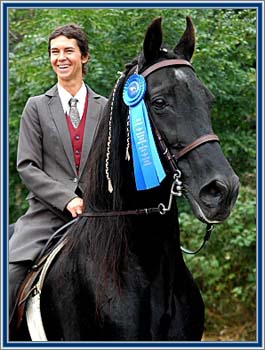|
|
 |

With Buster at the riding center of Ursula Bruns |
|
Bringing Lad’s Black
Buster home to the Netherlands was like the start of a
new era. He was the first Tennessee Walker in this
country and most probably the first gaited horse
stallion being promoted as such, apart from Icelandic
Horses. There had been imports before of American
Saddlebreds, but this was because of interest from
breeders in using them to enhance the presence of the
Dutch Tuigpaard, which had been done with Hackneys
before. So these ASHs were surely not imported because
of their rack, but because of their elevated trot.
|
| At the
time (1986) it was still legally
imperative both in Germany as
well as in the Netherlands, to
present a prospective breeding
stallion before a stallion
inspection commission. Only if
your horse was approved by them,
could he be offered at public
stud. Buster succeeded both in
Germany, for Schleswig-Holstein
where he was born, as well as in
the Netherlands, at the
“Staatshengstenkeuring” – State
Stallion Inspection, held in
Ermelo (Uddel). |

Buster is paying attention! |
|
|
| Later he
successfully did his performance test, a
further request of the Schleswig-Holstein
authorities, as well as an additional German
inspection for the Rheinisches
Pferdestammbuch, of the German country,
Nordrhein-Westphalia. |
|
|

At the Center in Reken, Germany, Ursula
Bruns discusses Tennessee Walkers with Rick
Wies, TWH trainer from Montana
|
For riding lessons
with a Tennessee Walker, virtually the only
place to go at the time was the center of
Ursula Bruns, at Reken, Westphalia. Now the FS Reit-Zentrum Reken, this
place is still recommended to visit.
|
|
|
There many
horse-people gathered and discussed their
interests, also Tennessee Walking Horse
riders. American horse-trainer
Linda Tellington-Jones was a frequent
guest there and she rode Buster too, clearly
appreciating him! |

Linda Tellington-Jones showing off
her new riding clothes on Buster. |
|
|
Anyway, when you have
a special horse like Buster, there is a good chance for
meeting celebrities. It was when I showed Buster in The
Hague, Netherlands, at the “Haagse Paardendagen”, that
we met Mario Luraschi. Mario’s job is cascadeur,
French for show-stuntman with horses. He is the guy
behind the horse and buffalo show at the French
Disneyland of Paris. Mario told me that he had imported
some Tennessee Walker geldings to France, to be used by
bird hunters. Hunting is very popular all over the
French countryside and of course a Tennessee Walker is a
very special choice to use for bird hunting! For sure,
Mario wanted to have a try riding Buster, when I offered
that. On the pavement of The Hague city, Buster did his
job carrying our French cascadeur around! |

Mario Luraschi in The Hague,
getting acquainted with Buster |

After riding Buster, a big smile
appeared on Mario's face! |
|
|
A very fine occasion
to present my horse to the public, with even our Dutch
Queen Beatrix among the spectators, was organized and
performed by my friend Linda van der Horst. It was a
show of the Dutch Side-Saddle Association (Nederlandse
Vereniging Het Dameszadel), held during the
CHIO of Rotterdam. |

Buster and Linda in action during the CHIO, both dressed
up very officially. |
|
This international
competition had interludes of various shows, among them
the side-saddle show. The show-group was composed of
several Dutch Warmbloods of the KWPN Studbook and one
Tennessee Walking Horse. A few horses of this group were
also shown jumping, among them this lone Tennessee
Walker! Whether our Queen noticed this smaller
horse with the peculiar gait, bravely taking the same
fences as the bigger ones, I cannot say, but at least
Buster was there, strutting his stuff. |

Buster taking one of the obstacles
at the Rotterdam show grounds. |

The side-saddle show group at the CHIO of
Rotterdam, Buster in front, quietly waiting
for the job. |
|
|

That's me in England, at the court of TWH
stud
Pride of '76, showing which breed I go for.
|
It will be clear from
all these “horsey” activities, that our main
goal is spreading the word about gaited
horses, especially Tennessee Walking Horses.
Also, my partner, Henk and I want to expand
these activities by involving handicapped
riders with this breed. For sure there are
many advantages for people with various
handicaps to ride a smooth gaited horse!
Physical strength, partly lost because of an
accident, can also be regained by
horse-riding, but preferably without the
stress induced by a trotting horse. |
|
| In Europe,
gaited horses had virtually disappeared, to
be found only in remote regions like
Iceland. In the America’s, on both
continents, gaited horses were often
fostered and shaped into various breeds.
Originally however, America’s gaited horses
came from Europe, imported after Columbus’
discovery of the New World. Americans
deserve credit for preserving these fabulous
gaited horses and strengthening their gaits
by selective breeding. We now welcome the
original European heritage of gaited horses
back on this continent! |

Beautiful portrait of
Postmark Delight,
3-gait champion in Alpenrod. Photo by
Hypo-Focus
|
|
 |
|
 |
 |
|